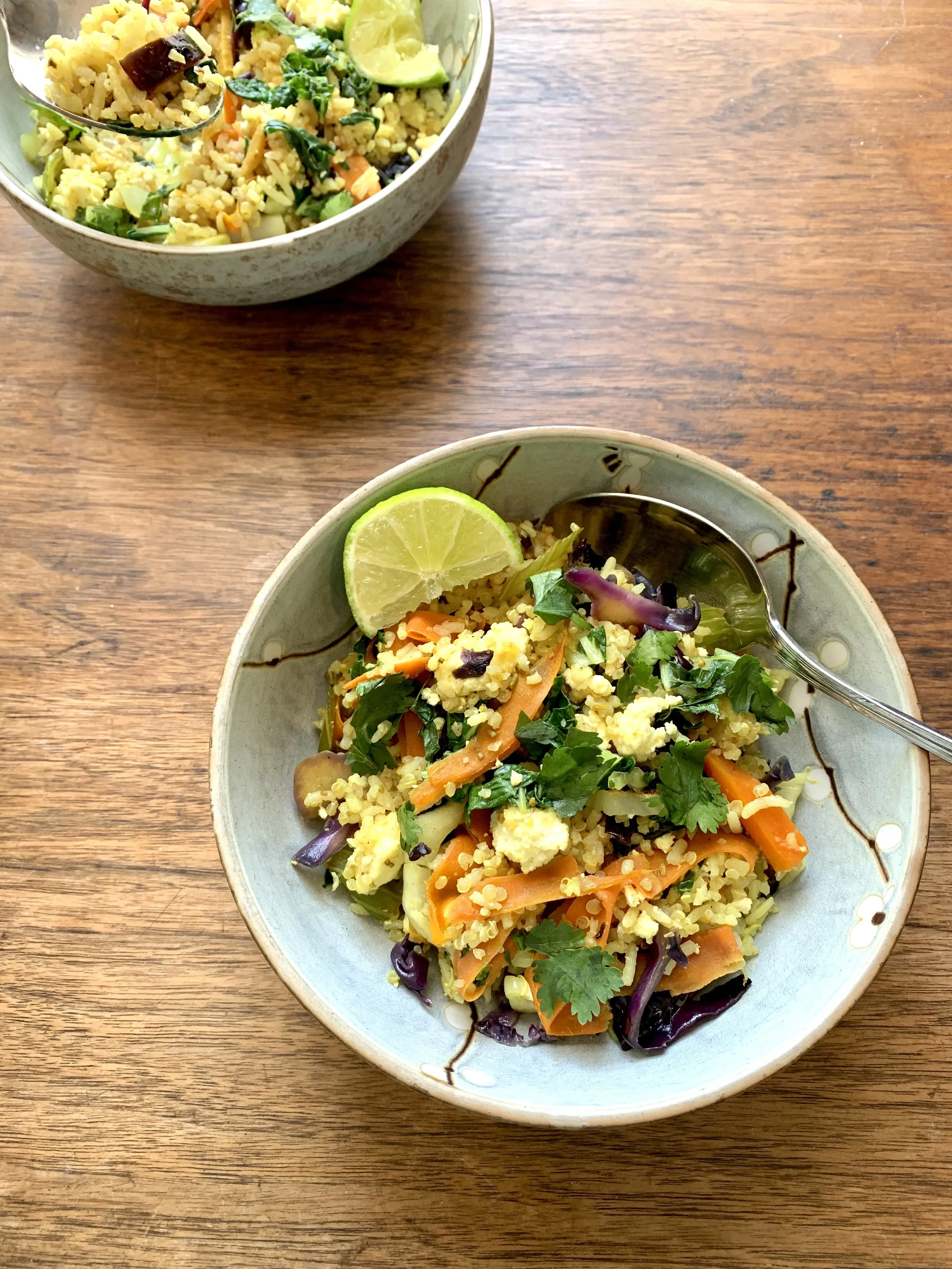Vegetarian Biryani
Welcome to my Ayurveda & Yoga blog! I’m Evangeline and I’m an RMT and holistic health coach. I started my blog during covid to stay connected to my clients and share my love of cooking healthy, AYURVEDIC INSPIRED meals.
Ayurvedic cooking is a conscious approach to preparing and cooking tasty, nutritious, balanced meals using spices and herbs, and taking into consideration the external conditions such as the season and time of day, in addition to how you are feeling.
Biryani is very popular in India, but has its roots in Persian cuisine. My husband loves vegetarian biryani! We always order this dish when dining out. It reminds me of fried rice with a burst of flavour. My youngest, when he was little, would fish out, in surprise, all the spices he would find in this dish, like cardamom pods, cloves, and a cinnamon stick or two. Aside from my husband’s love of this dish, I got turned on to making this dish for practical reasons. On days I had left over grains from making avocado rolls or a rice dish for school lunches I would make biryani for lunch.
Biryani is derived from a Persian dish called brinj birian which means fried rice. Brinj or berenj means rice and birian means fried. There is a reference here to the Sanskrit word vrihi, which means rice.
My vegetarian take on biryani is with paneer and a variety of vegetables, or I use chenna, a softer paneer, if I am short on time. I make it all year round, and use seasonal vegetables with spices that balance heating and cooling elements, not overpowering one over the other.
Vegetarian Biryani
Ayurvedic Profile of Spices
Black peppercorn - warming, opens up channels
Cardamom pods - helps digest protein
Cinnamon - warming quality; helps metabolize carbohydrate
Cloves - warming spice that does not aggravate pitta dosha
Coriander - cooling, ushers toxins out of the urinary tract
Cumin - helps in digestion and absorption of nutrients
Fennel - cooling, helps regulate and support digestion
Ginger root - warming, aids in digestion, relieves gas, anti-inflammatory
Saffron - anti-oxidant, anti-inflammatory, anti-depressant
Thai green chili - heating quality, increase agni/digestive fire
Turmeric - keeps the liver clean, known in Ayurveda as a “friend to the liver”, antioxidant, anti-inflammatory, antiviral, antibacterial
Vegetarian Biryani
Yield: 2-3 servings
Prep Time: 15 minutes
Cook Time: 20 minutes
INGREDIENTS
GRAINS
⅓ cup quinoa
⅓ cup basmati rice
¾ cup water
1 tsp ghee or olive oil
1 cinnamon stick
4 cloves
4 cardamom pods
A few strands of saffron
VEGETABLES & PANEER
1 Tablespoon ghee or olive oil
4 thin slices of ginger root
¼ tsp ground black pepper
½ tsp ground coriander
½ tsp ground fennel
¼ tsp ground cumin
⅛ tsp turmeric powder
1 small thai green chili (optional)
1 small carrot, shaved into ribbons
1 small zucchini, cut into half moon ½-inch thick
1 cup purple cabbage or kale, cut into small pieces
200 grams paneer, crumbled (chenna) or cut into small cubes—Paneer recipe here.
Salt to taste
instructions
If you are making your own paneer or chenna, make this first. Chenna, soft paneer takes about 10 minutes to make, while paneer takes about 20 minutes depending on how firm you want the paneer.
SAFFRON GRAINS
Soak basmati rice in water for at least 10 minutes, and rinse well.
Add water and spices, stirring all together.
Turn heat to high, and allow grains to boil for about 5 minutes, stirring occasionally.
Add ghee or olive oil, then cover with a lid, turn off stove, and cook for 15 minutes. Do not open lid while it’s cooking.
Fluff up the grains, and salt to taste if desired.
VEGETABLES AND PANEER
While grains are cooking, in a large pan or wok warm ghee or olive on medium heat, then add spices.
Cook harder vegetables first, like carrots covering with a lid for a few minutes, then add softer vegetables combining all together.
Add paneer, cut in cubes, or chenna towards the end of cooking all the vegetables.
PUTTING IT ALL TOGETHER
Fluff up the grains, and add it to the vegetables and paneer with salt and combine gently. Turn heat down to low and cover with lid, until ready to serve.
Garnish with fresh cilantro leaves, and add a squeeze of lime before serving.
Enjoy!
References
From Iran to India: The Journey and Evolution of Biriyani, https://www.bbc.com/news/world-asia-india-36423412#
Vaidya R. K. Mishra- Notes from Shaka Vansiya Ayurveda Courses, Practicum, Conferences and Lectures 2003-2015
The Effects of Crocus sativus (saffron) and its constituents on nervous system: A review, https://www.ncbi.nlm.nih.gov/pmc/articles/PMC4599112/
Saffron (Crocus sativus L.): As an Antidepressant, https://www.ncbi.nlm.nih.gov/pmc/articles/PMC6266642/

